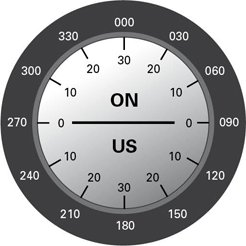Understanding the Magnetic Compass in Aviation
In the intricate realm of instrument flying, where precision is paramount, mastering the nuances of the magnetic compass becomes a vital skill. Magnetic dip, the phenomenon where the compass needle tilts due to the Earth’s magnetic field, becomes more pronounced at higher latitudes, resulting in significant discrepancies in readings, particularly when an aircraft accelerates or changes its heading. Pilots must possess a comprehensive understanding and the ability to rectify two primary compass errors: acceleration error and turning error.
Acceleration error, notably conspicuous on easterly or westerly headings, is encapsulated by the mnemonic "SAND" (representing South when Accelerating, North when Decelerating). This error triggers false indications on the compass during changes in the aircraft's speed. Adhering to the "SAND" principle aids pilots in recalling the compass's directional discrepancies during changes in speed, showing a deviation toward the south when accelerating and north when decelerating in the southern hemisphere.
On the other hand, turning error becomes apparent during medium-banked turns, where the compass card's inability to maintain a level orientation leads to a difference between the actual aircraft heading and the compass reading. Pilots employ the "ONUS" mnemonic (denoting Overshoot North, Undershoot South) to address these discrepancies. For northerly headings, pilots slightly overshoot before leveling out to compensate for the compass lag, while for southerly headings, they anticipate the roll-out before the compass aligns with the intended heading, adjusting for the compass's delay.
For instance, during a turn from a 090-degree to a 000-degree heading, choosing a left turn to swiftly reach the 000-degree mark in 30 seconds—an expedited alternative to a 90-second right hand rate 1 turn results in a compass turn error. During the left turn, the aircraft overshoots the intended heading, exceeding the 000-degree mark.
Image / CAA
In aviation, turning error holds more significance than acceleration error due to its substantial impact on navigation accuracy. When an aircraft executes a turn, the discrepancy between the actual heading and the compass reading becomes more pronounced, particularly during medium-banked turns. This difference could result in a significant deviation from the planned course, affecting navigation precision. While acceleration error is crucial, it usually leads to a false indication caused by speed changes rather than a substantial alteration in the aircraft's directional alignment.
During compass turns, a rate 1 turn is typically employed to ensure consistent and standardised manoeuvring. A rate 1 turn indicates a standard turn where the aircraft changes its heading at a rate of 3 degrees per second. This standardised rate helps maintain a predictable and controlled change in direction, aiding in consistent and known turning during navigation manoeuvres. Utilising rate 1 turns in compass maneuvers enables pilots to maintain a stable and predictable course alteration, contributing to more precise navigation and aiding in a better understanding and correction of compass errors.
Pilot training in compass turns is not solely about understanding the intricacies of these manoeuvres but also about developing the expertise to navigate directly from the magnetic compass in case of a Direction Indicator failure. This training equips pilots with practical experience in managing and rectifying deviations, ensuring safe and accurate navigation even when relying solely on the magnetic compass for guidance.
This comprehensive preparation refines the skills necessary to promptly identify and rectify compass errors under diverse circumstances, emphasising precision in navigation. By mastering the use of "SAND" and "ONUS," along with a profound understanding of magnetic dip, pilots can confidently navigate, ensuring accurate headings even when solely relying on the magnetic compass for guidance.
Mock Exam for Magnetic Compass
Further Reading: Compass use whiteboard layout - CAA


